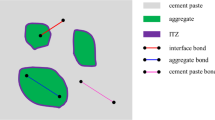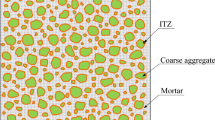Abstract
It has been experimentally verified that the structure of the interfacial transition zone (ITZ) in concrete differs from that of bulk cement paste. As such, concrete should be modeled as a three-phase material at a mesoscopic level. This paper presents a three-phase composite model for predicting the chloride diffusion coefficient of concrete. Taking the inclusion as aggregate and the matrix as cement paste, the composite circle model is established by adding an ITZ layer in between the inclusion and the matrix. Solving the asymmetrical problem analytically, a closed-form solution for the chloride diffusion coefficient of concrete is derived. After verifying this model with experimental results, the effects of the aggregate area fraction, the chloride diffusion coefficient of ITZ, the ITZ thickness, the maximum aggregate diameter and the aggregate gradation on the chloride diffusion coefficient of concrete are evaluated in a quantitative manner. It is found that the chloride diffusion coefficient of concrete decreases with the increase of the aggregate area fraction and the maximum aggregate diameter, but increases with the increase of the chloride diffusion coefficient and thickness of ITZ. It is also found that the aggregate gradation has a significant influence on the chloride diffusion coefficient of concrete.
Similar content being viewed by others

References
Nilsen AU, Monteiro PJM (1993) Concrete: a three phase material. Cement Concrete Res 23(1):147–151
Ollivier JP, Maso JC, Bourdette B (1995) Interfacial transition zone in concrete. Adv Cement Based Mater 2(1):30–38
Zheng JJ, Li CQ, Zhou XZ (2005) Characterization of the microstructure of interfacial transition zone in concrete. ACI Mater J 102(4):265–271
Garboczi EJ, Bentz DP (1997) Analytical formulas for interfacial transition zone properties. Adv Cement Based Mater 6(3):99–108
Li G, Zhao Y, Pang SS (1999) Four-phase sphere modelling of effective bulk modulus of concrete. Cement Concrete Res 29(6):839–845
Li CQ, Zheng JJ, Zhou XZ, McCarthy MJ (2003) A numerical method for the prediction of elastic modulus of concrete. Mag Concrete Res 55(6):497–506
Garboczi EJ, Schwartz LM, Bentz DP (1995) Modeling the influence of the interfacial zone on the DC electrical conductivity of mortar. Adv Cement Based Mater 2(5):169–181
Bourdette B, Ringot E, Ollivier JP (1995) Modelling of the transition zone porosity. Cement Concrete Res 25(4):741–751
Delagrave A, Bigas JP, Ollivier JP, Marchand J, Pigeon M (1997) Influence of the interfacial zone on the chloride diffusivity of mortars. Adv Cement Based Mater 5(3):86–92
Yang CC, Su JK (2002) Approximate migration coefficient of interfacial transition zone and the effect of the aggregate content on the migration coefficient of mortar. Cement Concrete Res 32(10):1559–1565
Yang CC, Cho SW (2003) Influence of aggregate content on the migration coefficient of concrete materials using electrochemical method. Mater Chem Phys 80(3):752–757
Caré S (2003) Influence of aggregate on chloride diffusion coefficient into mortar. Cement Concrete Res 33(7):1021–1028
Zheng JJ, Li CQ (2002) Three-dimensional aggregate density in concrete with wall effect. ACI Mater J 99(6):568–575
Zheng JJ, Li CQ, Zhao LY (2003) Aggregate distribution in concrete with wall effect. J Mater Civil Eng 15(5):506–510
Neville AM (1995) Properties of concrete. Pitmann Publishing, London
Devore JL (1995) Probability and statistics for engineering and the sciences. Duxbury Press, Belmont, US
Kendall MG, Moran PAP (1963) Geometrical probability. Charles Griffin & Company Limited, London
Lu BL, Torquato S (1992) Nearest-surface distribution functions for polydispersed particle system. Phys Rev A 45(8):5530–5544
Crank J (1975) The mathematics of diffusion. Clarendon Press, Oxford
Winslow DN, Cohen MD, Bentz DP, Snyder KA, Garboczi EJ (1994) Percolation and pore structure in mortars and concrete. Cement Concrete Res 24(1):25–37
Lobet A (2003) Influence des paramètres de composition des matériaux de composition des matériaux cimentaires sur les propriétés de transfert. PhD thesis, INSA, Toulouse
Acknowledgements
Financial support from the National Natural Science Foundation of P.R. China with Grant No. 50578147 is gratefully acknowledged.
Author information
Authors and Affiliations
Corresponding author
Rights and permissions
About this article
Cite this article
Zheng, J.J., Zhou, X.Z. Prediction of the chloride diffusion coefficient of concrete. Mater Struct 40, 693–701 (2007). https://doi.org/10.1617/s11527-006-9182-0
Received:
Accepted:
Published:
Issue Date:
DOI: https://doi.org/10.1617/s11527-006-9182-0



